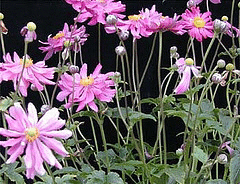Anemone
Anemone, graceful blooms for the shade garden
Perennial anemone includes a tremendous number of species which includes spring flowering bulbs, alpine plants, woodland plants, as well as garden plants. The var. japonica and x hybrida are known as the Japanese or Chinese windflower. Windflower is produced on fleshy tubers rather than bulbs. Windflower prefers filtered shade with humus enriched soil. Once established, they require virtually no care. In areas protected from the wind the blooms will remain for a longer period.
Anemone hupehensis var. japonica ‘Honorine Jobert’
Common Name: Japanese Windflower
Plant Type: Herbaceous perennial
Height: 3-4 feet
Spread: 12-24” or more if allowed to spread.
Sun/Shade Requirements: Half shade, full sun is tolerated in cool climates
Water Requirements: Keep soil consistently moist but not wet..
Soil Requirements: Moist rich soil is preferred. Will tolerate average to clay soil if well drained
Growth Habit: Compact mounding foliage with blooms on long stems
Bloom Time: Late summer to frost
Bloom Color: White
Bloom Form: Single 2” flowers with 6-9 overlapping petals and yellow centers on long stems
Foliage: Deeply divided dark green leaves.
Fragrance: None noted
Pest and Disease Resistance: Deer and rabbit resistant. May be susceptible to caterpillars and slugs.
Fertilize: Apply a general purpose fertilizer in spring and compost in autumn.
Maintenance: Requires virtually no care once established. Transplant and take root cuttings in spring. Divide in early spring or fall.
Other: Protect from wind. Does not tolerate humid climates. Attracts butterflies.
Hardiness: Zones 5-9
‘Honorine Jobert’ is a hybrid Anemone that is rumored to be hardy to Zone 4, but generally considered hardy to zone 5. It may need winter protection in zone 5 without snow cover. ‘Honorine Jobert’ is tolerant of average soil if it is well drained, and will also tolerate full sun in cooler climates. It does prefer part shade, moist rich soil and protection from wind. The plant may not due well in humid climates. Soil should be kept consistently moist. Foliage may burn in hot dry sun. The plant spreads by underground rhizomes and will naturalize. Tall plants exposed to wind may need support.
Large, single white blooms with yellow stamens are freely produced on long graceful stems in August through September. The plant is compact, forming an attractive mound and grows vigorously once established, spreading by underground shoots. It can spread rather aggressively, so select a location where it will not overtake other plants. ‘Honorine Jobert’ is an excellent cut flower and lovely in perennial borders, cottage gardens and woodland gardens. Stunning in masses.
Anemone hupehensis var. japonica x hybrida ‘Prince Henry’
Common Name: Japanese Windflower
Plant Type: Herbaceous perennial
Height: 18-30”
Spread: 24-30”
Sun/Shade Requirements: Half shade, full sun is tolerated in cool climates.
Water Requirements: Keep soil consistently moist but not wet.
Soil Requirements: Moist rich soil is preferred. Will tolerate average to clay soil if well drained
Growth Habit: Compact spreading mound of foliage with blooms on long stems.
Bloom Time: September through October frost.
Bloom Color: Deep rose-pink
Bloom Form: 2” semi-double flowers with 10-15 overlapping narrow petals and bright yellow centers.
Foliage: Deeply divided dark green leaves.
Fragrance: None noted
Pest and Disease Resistance: Deer and rabbit resistant. May be susceptible to caterpillars and slugs.
Fertilize: Apply a general purpose fertilizer in spring and compost in autumn.
Maintenance: Requires virtually no care once established. Transplant and take root cuttings in spring. Divide in early spring or fall.
Other: Protect from wind. Does not tolerate humid climates. Attracts butterflies.
Hardiness: Zones 5-8
‘Prince Henry’ has double blooms in a deep pink, appearing in late summer and continuing through fall. The vivid bloom color makes it a great accent or border plant. ‘Prince Henry’ is a compact variety of Japanese windflower, with slightly shorter flower stalks. The petals are narrow often with a notch at the end, and form a star shape.
‘Prince Henry’ prefers moist, average, well drained soil, but will tolerate clay if well drained. It will also tolerate full sun in cooler climates. The plant should be protected from wind to protect the blooms. The foliage may burn in hot dry sun. It is hardy in zones 5-8, but may require winter protection in zone 5 where snowcover is not reliable. The plant forms an attractive spreading mound that grows vigorously once established, spreading by underground shoots. It can spread rather aggressively, so select a location where it will not overtake other plants.
‘Prince Henry’ is an excellent cut flower and lovely in perennial borders, cottage gardens and woodland gardens. Stunning in masses.


